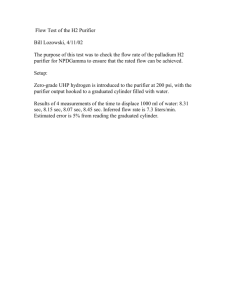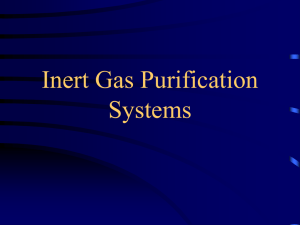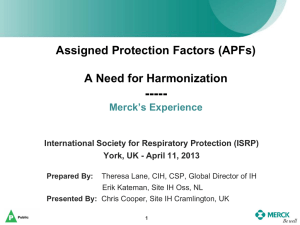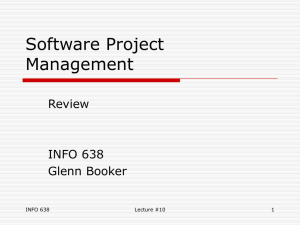Biological fouling of UV lamp sleeves:
advertisement
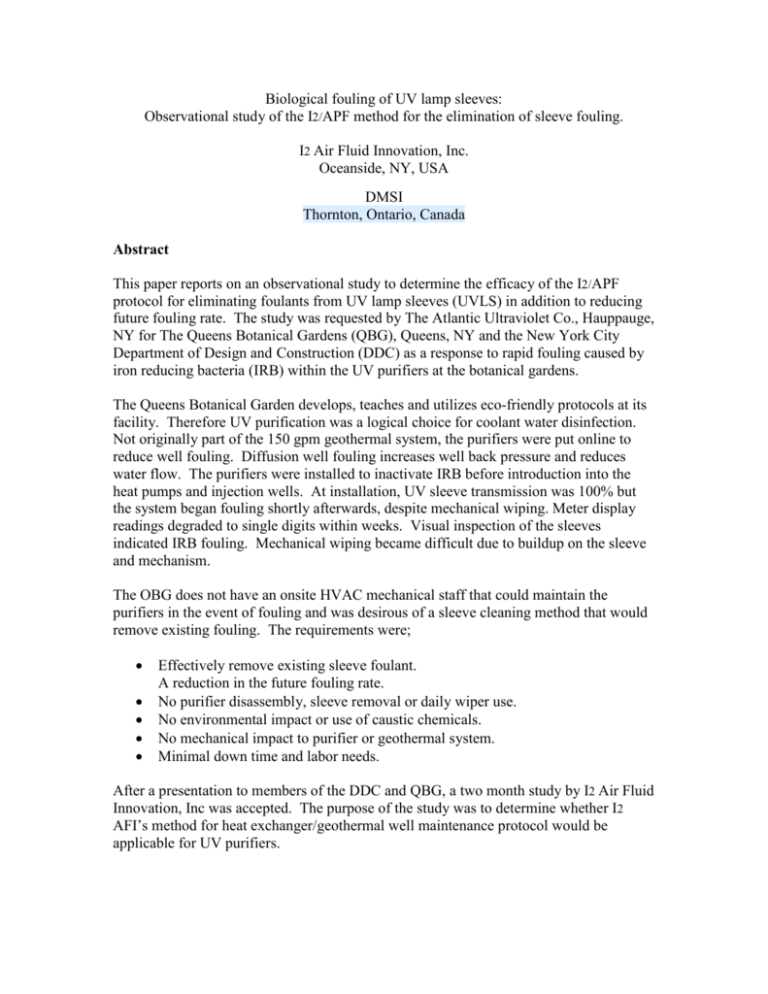
Biological fouling of UV lamp sleeves: Observational study of the I2/APF method for the elimination of sleeve fouling. I2 Air Fluid Innovation, Inc. Oceanside, NY, USA DMSI Thornton, Ontario, Canada Abstract This paper reports on an observational study to determine the efficacy of the I2/APF protocol for eliminating foulants from UV lamp sleeves (UVLS) in addition to reducing future fouling rate. The study was requested by The Atlantic Ultraviolet Co., Hauppauge, NY for The Queens Botanical Gardens (QBG), Queens, NY and the New York City Department of Design and Construction (DDC) as a response to rapid fouling caused by iron reducing bacteria (IRB) within the UV purifiers at the botanical gardens. The Queens Botanical Garden develops, teaches and utilizes eco-friendly protocols at its facility. Therefore UV purification was a logical choice for coolant water disinfection. Not originally part of the 150 gpm geothermal system, the purifiers were put online to reduce well fouling. Diffusion well fouling increases well back pressure and reduces water flow. The purifiers were installed to inactivate IRB before introduction into the heat pumps and injection wells. At installation, UV sleeve transmission was 100% but the system began fouling shortly afterwards, despite mechanical wiping. Meter display readings degraded to single digits within weeks. Visual inspection of the sleeves indicated IRB fouling. Mechanical wiping became difficult due to buildup on the sleeve and mechanism. The OBG does not have an onsite HVAC mechanical staff that could maintain the purifiers in the event of fouling and was desirous of a sleeve cleaning method that would remove existing fouling. The requirements were; Effectively remove existing sleeve foulant. A reduction in the future fouling rate. No purifier disassembly, sleeve removal or daily wiper use. No environmental impact or use of caustic chemicals. No mechanical impact to purifier or geothermal system. Minimal down time and labor needs. After a presentation to members of the DDC and QBG, a two month study by I2 Air Fluid Innovation, Inc was accepted. The purpose of the study was to determine whether I2 AFI’s method for heat exchanger/geothermal well maintenance protocol would be applicable for UV purifiers. Keywords Ultraviolet disinfection, iron, bio-fouling, UV sleeves, geothermal, heat exchanger, botanical gardens Introduction and background A geothermal heat pump is an eco-friendly cooling/heating system that pumps heat to or from the ground. It uses the earth as a source of heating or cooling. It is designed to take advantage of the moderate temperatures in the ground to boost efficiency and reduce the operational costs of heating and cooling systems. Geothermal systems are cost effective, generally returning cost of setup in reduced energy needs over 3-10 years. Open loop systems rely on a supply well as a water source, and diffusion or injection wells as a return site. As a means to utilize the temperature variant for facility use, a heat exchanger is used. Supply well water chemistry and bacteriological makeup are a concern since fouling on the plates within the exchanger reduces heat transfer. This increases the need for auxiliary heating or cooling reflecting in higher energy needs. Additionally, as bio-fouling occurs within the exchanger, pieces break off and cause downstream occlusion of screens within the diffusion or injection well. This has the effect of adding increased back pressure which slows water flow through the exchanger reducing heat draw. This condition adds additional load on supply well pumps increasing energy demand and reducing pump life. Although ultraviolet disinfection is a proven, eco friendly method for reducing microbial content within coolant water, fouling of the quartz sleeves may limit its effectiveness. Bacteriological films, bio-film, in conjunction with minerals present a difficult maintenance challenge. Bio-film is a polysaccharide matrix that sticks to surfaces and protects microbial colonies from potentially disruptive or destructive water conditions i.e., biocides, turbulence, etc. Bio-films draw in minerals that harden its composition making them difficult to remove with mechanical or automated wiping. Their growth extension into water flow reduces surface water velocity and allows for additional bacterial attachment. Iron bacteria derive its energy and multiply by oxidizing dissolved ferrous iron into insoluble ferric oxide. IRB forms a bio-film that appears as a brown gelatinous slime that coats quartz sleeves and breaks off for downstream occlusion. There are three identified mechanical methods that may initiate and promote fouling; Heat induced precipitation of metals on the sleeve surface. Foulant settling on the upper sleeve surfaces due to fluid motion and gravitational influence within the purifier chamber. Low velocity zones near sleeve surfaces and around fixtures that may impede water flow allowing for attachment. The I2 method is a patented protocol for the reduction of microbes through the intermittent infusion of iodinated air bubbles into a fluid. Used in the health industry and geothermal heat exchangers, the I2 method eliminates the needs for high levels of biocides through a novel air/iodine vapor/microbe interaction. Additionally, the bubble stream acts as an air sparging device which helps to prevent bacterial and mineral attachment. Used periodically, the APF protocol removes bio-film and minerals from internal surfaces through pressurization, purging, agitation cleaning and flush, using a proprietary cleaner prior to bubble stream introduction. It cleans interior components including sleeves, wipers and chamber and does not expose staff and environment to caustic chemicals. Objective 1. To determine the effectiveness of a protocol that uses an in-situ method for the disruption and removal of formed bio-film/mineral coatings on the UVLS. 2. To determine the reduction in fouling rate through the intermittent introduction of iodinated air bubbles into the purifier chamber by the; Elimination of low velocity zones. Removal of recently attached foulants. Prevention of Brownian motion and gravitational effects. Prevention of attachment of biological and inorganic foulants. Mitigation of higher temperature zones near the sleeve surface. Inactivation of bacteria within the purifier. Materials and methods Two isolated pairs of Atlantic Ultraviolet Sanitron 40 gpm purifiers in series Each purifier has a Guardian UV intensity meter and mechanical wiper. The study was performed under normal operating conditions and implemented during normal working hours. The sleeve cleaning method, the APF protocol, requires an air source, drain and water soluble APF cleaner. The iodinated bubble infusion is formed by the patented I2 Air Infuser. All infusion and drainage is done through the APF assembly attached to the purifier drain. The study would include the following; Initial testing of influent water to determine mineral and bacteriological composition. Selected purifiers to be subjected to the APF protocol with readings compared before and after to determine effectiveness in removing existing films. After cleaning, the purifier would be allowed to foul to determine rate of foul layer formation without I2 infusion. After cleaning, a comparison of the fouling rate in purifiers that have either I2 infusion or not. The APF protocol consists of purifier isolation, pressurization, purging, cleaner introduction, cleaner agitation and flush. The time allotted is 15 minute preparation, 40 minute agitation, and 5 minute flush. The I2 bubble infusion is produced by injecting iodinated air from the I2 Air Infuser Cartridge through diffuser tips into the purifier chamber. It was injected both constantly and intermittently throughout the trial period and the results compared. Three of the four purifiers were used for the study; upper front UF, upper back UB and lower front LF. Lower back LB was not used due to a malfunctioning meter. All services were performed by a member of I2 Air Fluid Innovation’s staff and overseen by members of the DDC who observed and confirmed all readings. Water composition as determined by IME test ampoules were as follows; Iron: 5 ppm Iron bacteria, slime producing Positive 24 hours/high 5/19/09 Start of study Prior APF protocol: UB (4), UF (1), LF (3) Note: Wipers were frozen. APF protocol was performed on UB and UF only. LF was untouched. A dilute, ½, strength cleaning solution was used and allowed to dwell for ½ the time without agitation to test for component compatibility. No damage was visible. Results: Following the initial protocol, readings read; UB (39), UF (37), LF (3) Wipers were freed considerably allowing for full stroke motion. No I2 infusion was performed 5/27/2009 APF protocol was performed on all three purifiers using a full strength solution. Meter readings afterwards read; UB (98), UF (100), LF (98). No I2 infusion was performed 6/3/2009 The APF protocol was performed on LF only. Meter readings afterwards read; UB (46), UF (38), LF (97). No I2 infusion was performed 6/10/2009 The APF protocol was performed on LF only. Meter readings afterwards read; UB (34), UF (37), LF (98). No I2 infusion was performed 6/17/2009 The APF protocol was performed on LF only. Meter readings afterwards read; UB (32), UF (27), LF (98). . Dried air was passed through the I2 cartridge and iodinated air was introduced to the LF purifier only at ¼ cfm @ 62 psi. Water pressure was 60 psi. I2 cartridge at start was weighed at 2118.2 grams. 6/22/2009 No cleaning protocol was performed. Air infused to LF only. Meter readings read; UB (30), UF (22), LF (93) Thursday 7/3/2009 No cleaning was performed. Air infused to LF only. Meter readings read; UB (11), UF (18), LF (87) Thursday 7/10/2009 Prior cleaning, meters read; UB (11), UF (14), LF (79) Purifiers UB, UF and LF were cleaned using the APF protocol. All meters read 100 at end of procedure. UF and LF received infused air intermittently every 24 hours. Thursday 7/17/2009 End of study No cleaning protocol was performed. All air infusion stopped. Purifiers with iodinated air infusion read; UF (96) and LF (94) Purifier UB without iodinated air was (57). I2 cartridge weighed 2113.1 indicating a loss of 5.1 grams of iodine after 4 weeks. Water composition: Water from UB Water from LF and UF: Iron 5 ppm, IRB positive 24 hours Iron 3 ppm, IRB negative 72+ hours Monday 8/3/2009 Meter readings read; UB (14), UF (42), LF (39). Results Bold APF protocol performed. Results afterwards Italic Received iodinated air infusion. Results next protocol session Date 5/17 5/17 5/27 6/3 6/17 6/22 7/3 7/10 7/10 7/17 8/3 UB 4 39 98 34 32 30 11 11 100 57 14 UF 1 37 100 37 27 22 18 14 100 96 42 LF 3 3 98 98 98 93 87 79 100 94 39 Note Meter reading start of study Meter reading after 50% APF Meter reading after 100% APF Infused air started to LF after APF All purifiers APF air to UF and LF Meter readings at end of study Note sleeve degradation Observations Prior study, all meters indicated advanced fouling with single digit readings. Visual observation of the sleeve and meter lens confirmed fouling. The foulant appeared to be a hardened, red/brown film not removed by mechanical means. Water composition testing presented high iron and the presence of slime forming IRB. Wiper mechanism was frozen on all tested purifiers. The meter lens had a red/brown stain on the leading edge to water flow. Cleaning the lens with oxalic acid and returned into the purifier meter readings rose slightly. Lens cleaning was always performed prior all meter readings. After cleaning the purifiers with the APF protocol, meter readings averaged 96. This was observed on multiple occasions and on various purifiers. The APF protocol was easy to implement and required no disassembly of the purifier or sleeve removal. The average procedure time was 67 minutes which included 40 minutes dwell time. The APF cleaner removed existing biological and mineral films through agitation and chemical cleaning. The sleeves appeared undamaged and transparent. Wiper mechanism became unfrozen and moved freely. Without I2 infusion, readings would decline by an average 40 to 60% within one week. Injecting I2 air into the purifier after cleaning, sleeve fouling declined approximately 6% to 10% a week. Observing the bubble pattern in flowing water from both distal and mesial ends of the quartz sleeve indicated an active profusion. The bubbles rose from the air inlet situated at the drain port, moved in a linear direction along and up the quartz sleeve to exit into the outlet port at the distal end of the purifier. Conclusions The APF protocol easily cleaned the interior components and appears to be a simple to implement method for maintaining sleeve transmissibility. The rapid cleaning allowed for both sets of purifiers to be cleaned in one session. The cleaner is active at varying dilutions which would allow use on larger or smaller systems. Implementation time would vary. Without the need for removal, sleeve and gasket integrity would be preserved. Sleeve replacement would be reduced or eliminated. Wiper use and mechanism failure would be reduced through foulant removal. The I2 infusion reduced fouling rate through a change in water flow pattern within the chamber. This appeared to eliminate low velocity zones and prevent sedimentation. The active bubbles appeared to act as a sparger, lifting existing bio-films and preventing attachment by planktonic bacteria and insoluble minerals. The infusion maintained meter readings long enough to allow for a monthly one hour APF protocol application. The protocol used approximately six grams of iodine in one month’s time. It appeared to have no physical effect on the purifiers, sleeves or interior components. Additionally, the bubbling had no effect on the system piping, gaskets or heat pumps. The bubbling appears to reduce the APF protocol time by presenting a reduced bio-film for removal. Intermittent infusion appeared as beneficial as constant. The protocol appears to have met all QBG requirements. Acknowledgments I2 Air Fluid wishes to thank all the members of the Queens Botanical Gardens for their assistance and participation during the study period as well as their devotion to uncovering eco-friendly methods. Special thanks to Peter Sansone and his staff for all their assistance and for their trust and use of the facility geothermal/UV system. Thank you to all the members of the NYC DDC for overseeing the implementation and result recording during the study protocol. Thanks Alex Posner, hydrogeologist, for his invaluable knowledge of geothermal systems and geochemistry. Lastly, thank you to the engineers at Atlantic Ultraviolet for their participation in this study. Bibliography Black & Veatch and the Electric Power Research Institute Community Environmental Center Report CR-105252 UV Disinfection for Water and Wastewater Treatment Sehnaoui, Karim and Gehr, Ronald Fouling of UV Lamp Sleeves: Exploring Inconsistencies in the Role of Iron., Contact For additional information contact info@i2airfluidinnovation.com USA and International larrysmiller@rogers.com Canada This study contains proprietary content or intellectual property and is intended for the sole educational use of the individual(s) or entity being presented to. Be aware that any disclosure, copying, distribution or use of the contents of this information is strictly prohibited without the authors’ written consent. Protocol and application is based upon the art and science of U.S. Patent No. 7,329,385 and is the intellectual property of the inventor(s) . Disclaimer of Warranties and Limitation of Liabilities NEITHER THE AUTHORS NOR ORGANIZATION ACTING ON BEHALF OF ANY OF THEM: (A) ASSUMES RESPONSIBILITY FOR ANY DAMAGES OR OTHER LIABILITY WHATSOEVER (INCLUDING ANY CONSEQUENTIAL DAMAGES RESULTING FROM YOUR SELECTION OR USE OF THIS STUDY OR ANY INFORMATION, APPARATUS, METHOD, PROCESS, OR SIMILAR ITEM DISCLOSED IN THIS REPORT.

